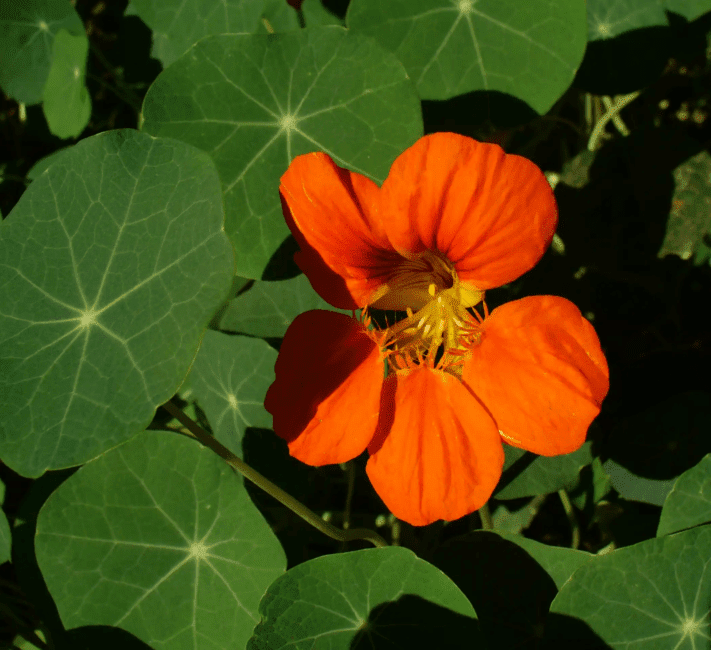Tropaeolum, commonly known as Nasturtium, is a genus of flowering plants that includes both annual and perennial species. Native to South and Central America, these plants are well-known for their vibrant and showy flowers, unique foliage, and versatility in gardens and culinary applications.
One of the distinctive features of Nasturtium is its rounded, shield-shaped leaves that are often deeply lobed. The leaves can vary in color, ranging from bright green to blue-green, and some varieties even display variegation. The foliage adds an ornamental aspect to the plant, contributing to its overall attractiveness.
Nasturtiums produce trumpet-shaped flowers that come in a variety of colors, including shades of red, orange, yellow, and cream. The flowers are typically held above the foliage on long, slender stems, creating a visually striking display.
The contrasting colors of the flowers against the green foliage make Nasturtiums popular choices for garden borders, hanging baskets, and container gardens.
These plants are often appreciated not only for their aesthetic appeal but also for their versatility in the kitchen. Both the leaves and flowers of Nasturtiums are edible, providing a peppery and slightly tangy flavor.
They are commonly used in salads, where they add a burst of color and a unique taste. Additionally, Nasturtium flowers can be used to garnish dishes, lending a touch of both flavor and visual interest.
Cultivating Nasturtiums is relatively easy, as they are adaptable to various soil types and can thrive in both full sun and partial shade. They are well-suited for gardens, borders, and hanging baskets, and their trailing or climbing habit makes them excellent for ground cover or vertical gardening.
Nasturtiums are also known for their ability to attract pollinators, such as bees and butterflies, making them valuable additions to pollinator-friendly gardens.
In addition to their ornamental and culinary uses, Nasturtiums are appreciated for their role in companion planting. The pungent aroma of the plant is believed to act as a natural deterrent to certain pests, making it a beneficial companion to other garden plants.
Tropaeolum, or Nasturtium, is a versatile and attractive genus of flowering plants. With their vibrant flowers, unique foliage, and culinary applications, Nasturtiums have earned a place in gardens and kitchens around the world.
Whether used as ornamental accents, tasty additions to salads, or as companion plants in the garden, Nasturtiums continue to be popular choices for both novice and experienced gardeners.
The Botanical Description of Tropaeolum
Tropaeolum, commonly known as nasturtium, represents a genus of flowering plants that exhibit distinctive characteristics in their botanical description:
1. Plant Structure: Tropaeolum plants typically feature trailing or climbing stems with round, shield-shaped leaves. The leaves are often palmately lobed, giving them a unique appearance.
2. Flowers: The flowers of Tropaeolum are vibrant and eye-catching, coming in various hues, including shades of red, orange, and yellow. The blooms are spurred, resembling a funnel or trumpet shape.
3. Spur Formation: One of the defining features of Tropaeolum is the spur, an elongated tubular extension from the back of the flower. This characteristic distinguishes it from other genera and contributes to its visual appeal.
4. Growth Habit: Tropaeolum species can exhibit different growth habits, ranging from low-ground cover varieties to climbing vines. The growth habit often depends on the specific species and environmental conditions.
5. Foliage: The leaves of Tropaeolum plants are succulent and can be quite pungent, with a peppery aroma and taste. This distinctive flavor is one reason why some varieties are used in culinary applications.
6. Reproduction: Tropaeolum reproduces via seeds, and the plants are known for their prolific seed production. This contributes to their ability to self-seed and naturalize in suitable environments.
7. Root System: The root system of Tropaeolum is generally shallow, contributing to its suitability for container gardening. The plants are known for their adaptability to various soil types.
8. Seasonal Behavior: Tropaeolum is often grown as an annual, with a seasonal life cycle. However, some perennial species exist, and the plants can exhibit different behaviors based on climate and growing conditions.
The Geographic Distribution of Tropaeolum
Tropaeolum has a diverse geographic distribution, with different species thriving in various regions around the world:
1. Native Regions: The genus Tropaeolum is native to South and Central America, particularly the Andes Mountains. Nasturtium species are adapted to a range of altitudes and climates within this region.
2. Global Cultivation: Due to the ornamental and culinary appeal of Tropaeolum, it has been cultivated and naturalized in many parts of the world. It is a popular choice in gardens and landscapes, appreciated for its vibrant flowers and edible leaves.
3. European Introduction: Tropaeolum species were introduced to Europe in the 16th century, where they gained popularity for their aesthetic value. The plants’ adaptability contributed to their widespread cultivation.
4. Adaptation to Different Climates: Tropaeolum demonstrates adaptability to various climates, from temperate regions to more tropical environments. This adaptability has contributed to its success as a globally cultivated plant.
5. Culinary Use in Different Cuisines: Some Tropaeolum varieties, particularly nasturtiums, are cultivated for culinary use. They are grown in kitchen gardens and used in salads, providing a peppery flavor to dishes.
The Chemical Composition of Tropaeolum
The chemical composition of Tropaeolum, particularly nasturtiums, contributes to both their flavor and potential health benefits:
1. Peppery Compounds: The characteristic peppery taste of Tropaeolum, especially in nasturtium leaves, is attributed to compounds like glucosinolates. These compounds are also found in other cruciferous vegetables.
2. Antioxidants: Tropaeolum plants contain antioxidants, including vitamin C and beta-carotene. These antioxidants play a role in neutralizing free radicals and supporting overall health.
3. Essential Oils: Some species of Tropaeolum, including nasturtium, contain essential oils that contribute to their aroma and flavor. These oils may have antimicrobial properties.
4. Phytochemicals: Tropaeolum is rich in phytochemicals with potential health benefits. These include flavonoids, which are known for their anti-inflammatory and antioxidant properties.
5. Nutritional Content: Nasturtium leaves are a good source of vitamins and minerals, including vitamin A, vitamin C, and iron. The nutritional profile adds to the appeal of using nasturtium in culinary applications.
6. Antibacterial Properties: Compounds found in Tropaeolum, such as isothiocyanates, have been studied for their antibacterial properties. This aspect adds to the potential health benefits of including nasturtium in the diet.
7. Culinary Uses: The chemical composition of Tropaeolum, especially the peppery flavor and nutritional content, makes it a versatile ingredient in the kitchen. Nasturtium leaves and flowers are used in salads, sandwiches, and garnishes.
8. Traditional Uses: Beyond culinary uses, Tropaeolum has a history of traditional medicinal applications. Some cultures have utilized the plants for their potential diuretic and expectorant properties.
Read Also: 16 Medicinal Health Benefits Of Teucrium chamaedrys (Germander)
The Medicinal Health Benefits Of Tropaeolum (Nasturtium)

Nasturtium, scientifically known as Tropaeolum, offers a range of medicinal health benefits, making it a valuable addition to traditional and herbal medicine:
1. Immune System Support: Tropaeolum, especially nasturtium, contains compounds like vitamin C and glucosinolates, which contribute to immune system support. Regular consumption may help in preventing common illnesses.
2. Respiratory Health: The expectorant properties of nasturtium make it beneficial for respiratory health. It is often used to alleviate symptoms of coughs and colds by promoting the expulsion of mucus.
3. Antibacterial Action: Tropaeolum exhibits antibacterial properties, with studies suggesting that it may help combat certain bacterial infections. This makes it a natural option for individuals seeking alternatives to conventional antibiotics.
4. Rich in Antioxidants: Nasturtium is rich in antioxidants, including beta-carotene and lutein. These antioxidants help neutralize free radicals in the body, potentially reducing the risk of chronic diseases.
5. Diuretic Effects: The diuretic properties of Tropaeolum may aid in promoting kidney function and reducing water retention. This makes it beneficial for individuals looking to support their urinary system.
6. Anti-Inflammatory Properties: Compounds found in Tropaeolum, such as glucosinolates, contribute to its anti-inflammatory effects. This can be particularly beneficial for individuals dealing with inflammatory conditions.
7. Digestive Aid: Nasturtium has traditionally been used to support digestion. It may help stimulate the production of digestive enzymes and improve overall digestive health.
8. Wound Healing: Applied topically, extracts from Tropaeolum may aid in wound healing. Its antimicrobial properties can help prevent infections, and the plant’s natural compounds may promote tissue regeneration.
9. Potential Anticancer Properties: Some studies suggest that Tropaeolum, specifically certain compounds found in nasturtium, may have potential anticancer properties. However, further research is needed to establish its efficacy in cancer prevention and treatment.
10. Respiratory Allergy Relief: For individuals dealing with respiratory allergies, Tropaeolum may provide relief. Its anti-inflammatory and expectorant properties can help alleviate symptoms such as congestion and difficulty breathing.
The Methods of Usage to Achieve the Provided Health Benefits Of Tropaeolum (Nasturtium)
To use the medicinal health benefits of Tropaeolum, various methods of usage can be employed:
1. Culinary Applications: Incorporating nasturtium leaves and flowers into salads, soups, or sandwiches is a delicious way to enjoy the health benefits. The peppery flavor adds a unique twist to culinary creations.
2. Herbal Infusions: Creating herbal infusions or teas using Tropaeolum leaves allows for the extraction of beneficial compounds. This is a simple and soothing way to promote immune and respiratory health.
3. Topical Applications: For wound healing and skin-related benefits, Tropaeolum extracts can be applied topically. Creams or ointments containing nasturtium extracts may aid in promoting skin health.
4. Tinctures and Extracts: Tinctures and liquid extracts made from Tropaeolum are convenient forms for medicinal use. These can be taken orally, providing a concentrated dose of the plant’s beneficial compounds.
5. Syrups: Syrups made from Tropaeolum can be a sweet and palatable way to ingest its medicinal properties. This is especially useful for individuals who may find the peppery taste too strong in other preparations.
6. Herbal Supplements: Capsules or tablets containing Tropaeolum extracts are available as herbal supplements. These provide a convenient option for individuals looking to incorporate the plant’s benefits into their routine.
7. Steam Inhalation: Inhaling steam infused with Tropaeolum extracts can be beneficial for respiratory health. This method helps in clearing the respiratory passages and may provide relief from congestion.
8. Poultices: Creating poultices using Tropaeolum extracts and applying them to wounds or areas of inflammation can facilitate healing. This direct application allows for the localized effect of the plant’s medicinal properties.
The Side Effects Of Using Tropaeolum Medicinal Plant
While Tropaeolum is generally considered safe when used appropriately, it’s important to be aware of potential side effects:
1. Gastrointestinal Discomfort: Some individuals may experience mild gastrointestinal discomfort, including stomach upset or nausea, especially when consuming larger amounts.
2. Allergic Reactions: Individuals with known allergies to plants in the Brassicaceae family, which includes nasturtium, should exercise caution. Allergic reactions may include skin irritation or respiratory symptoms.
3. Interactions with Medications: Tropaeolum may interact with certain medications. Individuals taking medications should consult with healthcare professionals before incorporating Tropaeolum into their routine.
4. Photosensitivity: In some cases, topical application of Tropaeolum extracts may cause photosensitivity. Individuals using these extracts on the skin should take precautions to avoid prolonged sun exposure.
5. Pregnancy and Breastfeeding: While Tropaeolum is generally safe in culinary amounts, pregnant and breastfeeding individuals should consult healthcare providers before using it in larger medicinal quantities.
6. Blood Pressure Effects: Tropaeolum may have a mild diuretic effect, affecting blood pressure. Individuals with pre-existing blood pressure issues should monitor their levels closely.
7. Liver Health: Some studies suggest that Tropaeolum may influence liver function. Individuals with liver disorders should exercise caution and consult healthcare professionals.
8. Not a Substitute for Professional Medical Advice: It’s essential to emphasize that Tropaeolum, while possessing medicinal properties, is not a substitute for professional medical advice. Individuals with medical conditions should seek guidance from healthcare providers before using it medicinally.
Read Also: How to Farm and Care for Araucanian Herring Fish (Clupea bentincki)
The Scientific Research and Studies of Tropaeolum (Nasturtium)

Scientific research and studies have delved into the various aspects of Tropaeolum, shedding light on its medicinal properties and potential health benefits:
1. Antimicrobial Properties: Numerous studies have explored the antimicrobial properties of Tropaeolum, with a focus on compounds like glucosinolates. These compounds exhibit potential in combating various bacteria and fungi, highlighting Tropaeolum’s role as a natural antimicrobial agent.
2. Anti-Inflammatory Effects: Research has investigated the anti-inflammatory effects of Tropaeolum, particularly in the context of conditions involving inflammation. Compounds found in the plant, such as isothiocyanates, have shown promise in modulating inflammatory responses.
3. Antioxidant Capacity: The antioxidant capacity of Tropaeolum has been a subject of scientific inquiry. Studies indicate that the plant’s rich content of antioxidants, including vitamin C and beta-carotene, contributes to its ability to neutralize free radicals in the body.
4. Potential Anticancer Properties: Some scientific studies suggest that certain compounds present in Tropaeolum may have potential anticancer properties. However, it’s crucial to note that research in this area is ongoing, and further investigations are needed to establish the efficacy and safety of Tropaeolum in cancer prevention and treatment.
5. Immunomodulatory Effects: Scientific research has explored the immunomodulatory effects of Tropaeolum, particularly in relation to the immune system. Compounds within the plant may play a role in modulating immune responses, making it a subject of interest in autoimmune and immune-related conditions.
6. Nutritional Analysis: Various studies have conducted nutritional analyses of Tropaeolum, providing insights into its vitamin and mineral content. Understanding the nutritional profile contributes to a comprehensive view of the plant’s health-promoting properties.
7. Wound Healing Properties: Scientific investigations into the wound healing properties of Tropaeolum have been conducted, especially concerning topical applications. Extracts from the plant may facilitate wound healing through antimicrobial and regenerative mechanisms.
8. Safety and Toxicology Studies: To ensure the safe use of Tropaeolum, safety and toxicology studies have been undertaken. These studies assess potential adverse effects and help establish appropriate dosages for medicinal applications.
The Safety Precautions and Recommendations In Using Tropaeolum (Nasturtium) Medicinal Plant
While Tropaeolum offers medicinal benefits, it’s essential to observe safety precautions and recommendations for its use:
1. Dosage Considerations: When using Tropaeolum for medicinal purposes, it’s crucial to adhere to recommended dosage guidelines. Excessive consumption may lead to adverse effects, and consultation with a healthcare professional is advisable, especially for concentrated forms like extracts or supplements.
2. Allergy Screening: Individuals with known allergies to plants in the Brassicaceae family, such as mustard or cabbage, should exercise caution. Allergic reactions, including skin irritation or respiratory symptoms, may occur. Performing an allergy screening before regular use is prudent.
3. Pregnancy and Breastfeeding: Pregnant and breastfeeding individuals should consult healthcare providers before using Tropaeolum medicinally. While it is generally safe in culinary amounts, caution is advised when considering larger medicinal quantities.
4. Interaction with Medications: Tropaeolum may interact with certain medications, impacting their efficacy or causing adverse effects. Individuals taking medications, especially those with anticoagulant or antiplatelet properties, should seek guidance from healthcare professionals.
5. Photosensitivity Concerns: Topical applications of Tropaeolum extracts may cause photosensitivity in some individuals. Those using extracts on the skin should take precautions to avoid prolonged sun exposure.
6. Monitoring Blood Pressure: Due to the potential diuretic effects of Tropaeolum, individuals with pre-existing blood pressure issues should monitor their levels closely. Adjustments to medication may be necessary under the guidance of healthcare professionals.
7. Liver Health Considerations: Individuals with liver disorders should exercise caution when using Tropaeolum, as some studies suggest an influence on liver function. Professional advice is recommended for those with existing liver conditions.
8. Professional Guidance: Before incorporating Tropaeolum into a medicinal routine, seeking professional guidance, especially from healthcare practitioners or herbalists, is advisable. This is particularly important for individuals with existing health conditions or those on prescribed medications.
FAQs About Tropaeolum (Nasturtium) Medicinal Plant
1. Is Tropaeolum safe for pregnant women?
Pregnant women should exercise caution and consult with healthcare providers before using Tropaeolum medicinally. While it is generally safe in culinary amounts, larger medicinal quantities may have different effects.
2. Can Tropaeolum be used as a substitute for antibiotics?
While Tropaeolum exhibits antimicrobial properties, it should not be used as a substitute for antibiotics without professional guidance. Consulting with healthcare providers is essential for proper treatment.
3. Are there age restrictions for using Tropaeolum medicinally?
Caution is advised for children, and the use of Tropaeolum should be tailored to individual needs and health status. Consultation with healthcare professionals is recommended.
4. Can Tropaeolum be applied topically for skin conditions?
Topical applications may be considered for certain skin conditions, but formulations should be carefully chosen to avoid adverse reactions. Patch testing is advisable.
5. Are there known interactions between Tropaeolum and medications?
Tropaeolum may interact with certain medications, especially those with anticoagulant or antiplatelet properties. Individuals on medication should seek guidance from healthcare professionals.
6. Can Tropaeolum be cultivated at home for personal use?
Cultivating Tropaeolum at home is feasible, but caution is advised due to its potential effects and the need for controlled environments. Sourcing from reputable suppliers is preferable.
7. Are there any known contraindications for using Tropaeolum?
Contraindications may include allergies, pregnancy, breastfeeding, and certain medical conditions. Individuals with these considerations should avoid its use without professional advice.
Read Also: How to Get Started with Sugar Cane Minecraft

